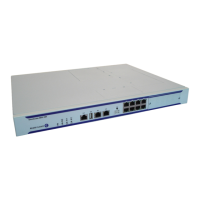Interface Configuration
7750 SR OS Interface Configuration Guide Page 29
Associated Signaling (CAS) options. CAS configuration must be identical for all channel groups
on a given DS-1 or E-1.
Circuits encapsulated in MPLS will use circuit pipes (Cpipes) to connect to the far end circuit.
Cpipes support either SAP-spoke SDP or SAP-SAP connections.
Circuits encapsulated in Ethernet can be selected as a SAP in Epipes. Circuits encapsulated in
Ethernet can be either SAP-spoke SDP or SAP-SAP connections for all valid epipe SAPs. An EC-
ID and far-end destination MAC address must be configured for each circuit.
Each OC-3/STM-1 port can be independently configured to be loop-timed or node-timed. Each
OC-3/STM-1 port can be configured to be a timing source for the node. Each DS-1 or E-1 channel
can be independently configured to be loop-timed, node-timed or adaptive. One adaptive timed
circuit is supported per CMA/MDA. The CES circuit configured for adaptive timing can be
configured to be a timing source for the node. This is required to distribute network timing to
network elements which only have packet connectivity to network.
On the 7750 SR-c12 CES CMA, a BITS port is also provided. The BITS port can be configured as
one reference sources (ref1, ref2) in the system timing subsystem.
Network Interconnections
With the introduction of Alcatel-Lucent’s 7750 SR-Series, the SR-Series product family can fill
the needs of smaller service providers as well as the more remote point of presence (PoPs)
locations for larger service providers. To support the use of lower speed links as network links in
the likelihood that lower speed circuits are used as network or backbone links, the 7750 SR-Series
supports a DS-1/E-1/DS-3/E-3 port (ASAP MDAs) or channel and an MLPPP bundle (ASAP
MDAs) as network ports to transport and forwarding of all service types. This feature allows
service providers to use lower speed circuits to interconnect small PoPs and CoS that do not
require large amounts of network/backbone bandwidth.

